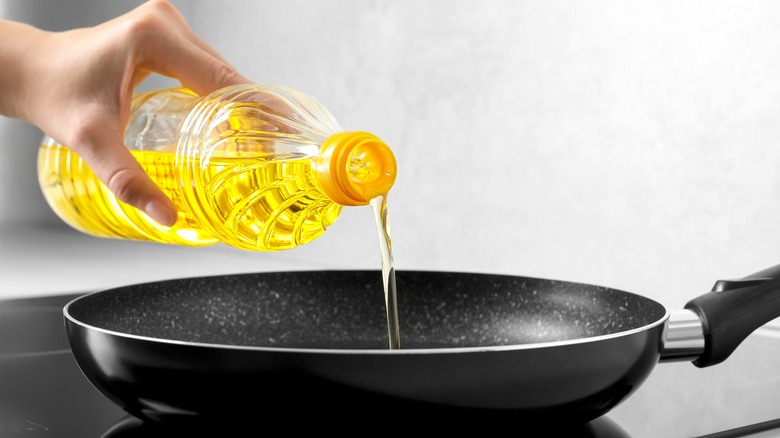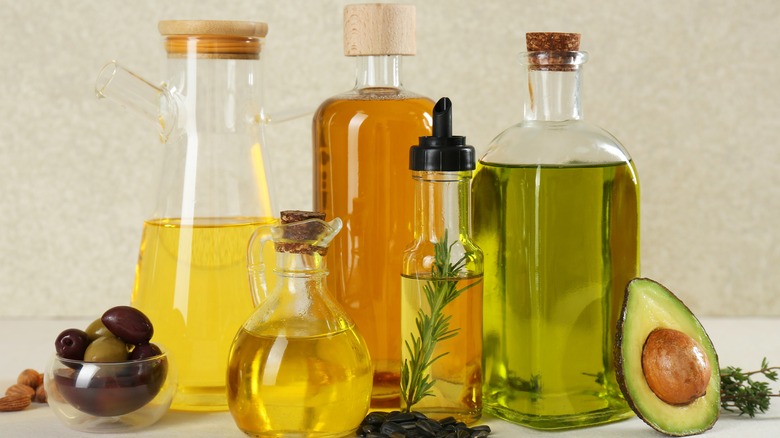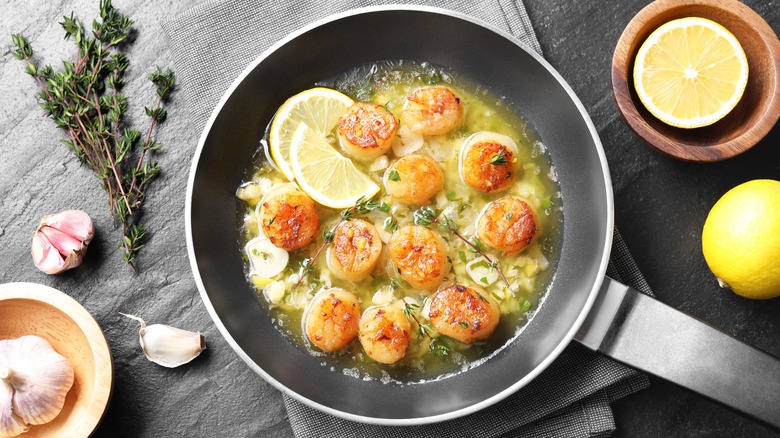The Best Type Of Oil To Use For Shallow Frying
Sometimes, even the most basic cooking maneuvers benefit from a reappraisal. It's all too easy to get caught in a culinary routine, and not realize it's detrimental to the final result. An excellent example of such an often misguided choice is the go-to cooking oil; not any bottle laying around will do. For example, say you're shallow frying, which means you're using a generous amount of oil to sauté or stir fry, slightly submerging food in the process. You'll want to carefully select your oil, or else you're risking an off-tasting and unhealthy meal.
The best candidates are mild-flavored, higher smoke point oils like safflower, sunflower, and canola. All have a taste that leans on the neutral side, with sunflower offering a slight palatable nuttiness to foods. Plus, such oils are high in unsaturated fats, which unlike animal-based cooking, offer a healthier alternative. As a result, such vegetable-based neutral oils dependably hit such notes without affecting the cooking process. So double check you have some in your pantry; these varieties are worth having around.
Select oils that won't interfere with the cooking process
There are several factors to consider when selecting an oil for shallow frying. You'll want durability — meaning a higher smoke point — a pleasant price tag, and a nice flavor that won't distract from your dish. It's a lot to consider at once, however, there is some malleability to your oil selection. Shallow frying won't heat up quite as hot as deep-drying, so it's an acceptable place to use a higher smoke point like olive oil. And especially if you're making vegetables, avocado oil lends a nice creamy touch.
Nevertheless, some types are worth completely avoiding for stovetop preparation. Under no circumstance employ oils meant for finishing dishes, like sesame, perilla, and nut-based varieties such as walnut and hazelnut. These are both expensive, and start losing their aromatic nature after only a little time on the pan.
Additionally, you'll want to avoid unrefined varieties, which contain more nutrients, but their more intricate structures break down at lower heat, producing potentially toxic compounds. So note the difference between refined and extra virgin olive oil on the label; just a single word on the label makes it less suitable for the heat applications in the kitchen.
Tailor your oil further to the specific dish
Furthermore, consider oil distinctions based on the specific application; it makes sense you'll want to check up on the best kinds of oils to use when you're deep-frying fish, as opposed to pan-frying vegetables. And you can even get more nuanced with your shallow frying preparation, carefully selecting the most specific oil for each dish.
If you're employing more delicate ingredients — especially with a Mediterranean palate — olive oil will work for shallow frying; just make sure to avoid heating it up excessively. And if you'd like to get the skin on a fish filet extra crispy, then rapeseed oil is an excellent option. If you're making fritters, then the nutty notes of sunflower oil will complement the batter. However, if you're stir frying (or just feeling unsure) then stick to safflower or canola. Since these oils are also fit for deep frying, you won't have to worry about ruining your meal.
Typically, the higher the heat of the employed oil, the less flavor it'll possess, a correlation worth keeping in mind. So if your shallow fry is steering into an especially hot direction — say you're making animal proteins — you'll want to adjust. A thermometer is always handy to keep an eye on the process, or use Rachael Ray's quick trick to tell when frying oil is hot enough. Just take some precautions in mind, and you'll be set.


